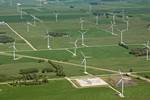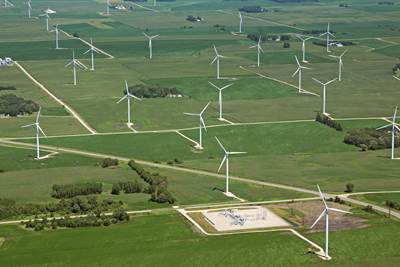Continuum targets facility capacity, transforms composite materials to advance wind blade recycling
The Denmark company details a CO2-neutral transformation technology to make 100% recyclable wind blades, plans to build six recycling facilities.
Denmark-based Continuum Composite Recycling was founded to target the wind blade recycling initiative taking place across the globe. In order to abandon landfilling and to significantly reduce the CO2 emitted during current “recycling” processes like incineration and co-processing in cement facilities, Continuum is targeting composite material transformation to achieve more eco-friendly, fully recyclable wind turbine blades. The company is also anticipating the need for increased recycling capacity, expecting to develop several industrial-scale factories. Combined, Continuum believes it can reduce wind blade disposal by 100 million tonnes by 2050.
“As a society we are rightly focused on renewable energy production, however the subject of what to do with wind turbine blades in the aftermath of that production has not been effectively addressed,” Nicolas Derrien, CEO of Continuum Holdings ApS, says per the offshoreWIND.biz announcement. “We’re changing that, offering a recycling solution for the blades and a construction product that will outperform most other existing construction materials and be infinitely recyclable, and with the lowest carbon footprint in its class.”
To achieve its goals, Continuum is reusing composites via a CO2-neutral transformation technology — final material is said to be made up of 92% recycled material. This material is used to created composite panels for the construction industry and the manufacture of day-to-day products such as facades, industrial doors and kitchen countertops. Per a technical overview on the company’s website, Continuum describes its material transformation process:
- Continuum organizes the transport and logistics of feedstocks from wind blades, automotive, marine and manufacturing waste — primarily glass fiber/polyurethane (GRP/PUR) — to its facility according to client needs.
- During material reclamation and reprocessing, the company mechanically transforms and separates feedstock materials back into their raw, basic constituents through a variety of process such as cutting, milling, breaking, screening, gravity-separating, sorting, sifting, cleaning and storing. The system is said to optically sort out formerly embedded carbon fiber; all ferrous and non-ferrous metals and pollutants are separated and sent off for further recycling.
- Fibers (glass, carbon fiber, etc.) are cut to <20 millimeters.
- PUR and fillers are ground to <1.5 millimeters.
- Binders (epoxies and resins) are also ground to <2 millimeters.
- After these processes, Continuum creates new compound blends “based on the classified, reclaimed materials together with virgin resin(s) and/or other formaldehyde-free additives.” Additional material/blends can be developed, depending on application needs.
- High-performance, high-density (single or multi-layered) panels are development. Mats comprising the blended composite materials are formed, pre-compressed and then placed under high heat and pressure in a continuous press to form the final product.
According to offshoreWIND.biz, Continuum, which is already present in Denmark and the U.K., plans to build six factories, the first of which will be in Esbjerg, Denmark, and is expected to be operational by the end of 2024, followed by a second factory in the U.K. After the first two facilities, the company plans to build four more by 2030 in France, Germany, Spain and Turkey. Continuum estimates that each facility will have the capacity to “recycle a minimum of 36,000 tonnes of EOL turbine blades per year and will be designed to be powered only by 100% green energy, with zero carbon emitting environments.”
The company says it will be able to begin taking end-of-life (EOL) wind blades by the end of 2023.
Related Content
TU Munich develops cuboidal conformable tanks using carbon fiber composites for increased hydrogen storage
Flat tank enabling standard platform for BEV and FCEV uses thermoplastic and thermoset composites, overwrapped skeleton design in pursuit of 25% more H2 storage.
Read MorePlant tour: Albany Engineered Composites, Rochester, N.H., U.S.
Efficient, high-quality, well-controlled composites manufacturing at volume is the mantra for this 3D weaving specialist.
Read More3D-printed CFRP tools for serial production of composite landing flaps
GKN Aerospace Munich and CEAD develop printed tooling with short and continuous fiber that reduces cost and increases sustainability for composites production.
Read MoreThe potential for thermoplastic composite nacelles
Collins Aerospace draws on global team, decades of experience to demonstrate large, curved AFP and welded structures for the next generation of aircraft.
Read MoreRead Next
Regen Fiber launches eco-friendly wind blade recycling process
Regen Fiber’s sustainable recycling process keeps wind blades out of landfills by converting them into raw materials for use in asphalt, composite products and more.
Read More“Structured air” TPS safeguards composite structures
Powered by an 85% air/15% pure polyimide aerogel, Blueshift’s novel material system protects structures during transient thermal events from -200°C to beyond 2400°C for rockets, battery boxes and more.
Read MorePlant tour: Daher Shap’in TechCenter and composites production plant, Saint-Aignan-de-Grandlieu, France
Co-located R&D and production advance OOA thermosets, thermoplastics, welding, recycling and digital technologies for faster processing and certification of lighter, more sustainable composites.
Read More



























